Kuvings EVO820 Whole Slow Juicer review
The Kuvings EVO820 Whole Slow Juicer is a versatile appliance, allowing you to make smoothies, frozen desserts, and even nut milk
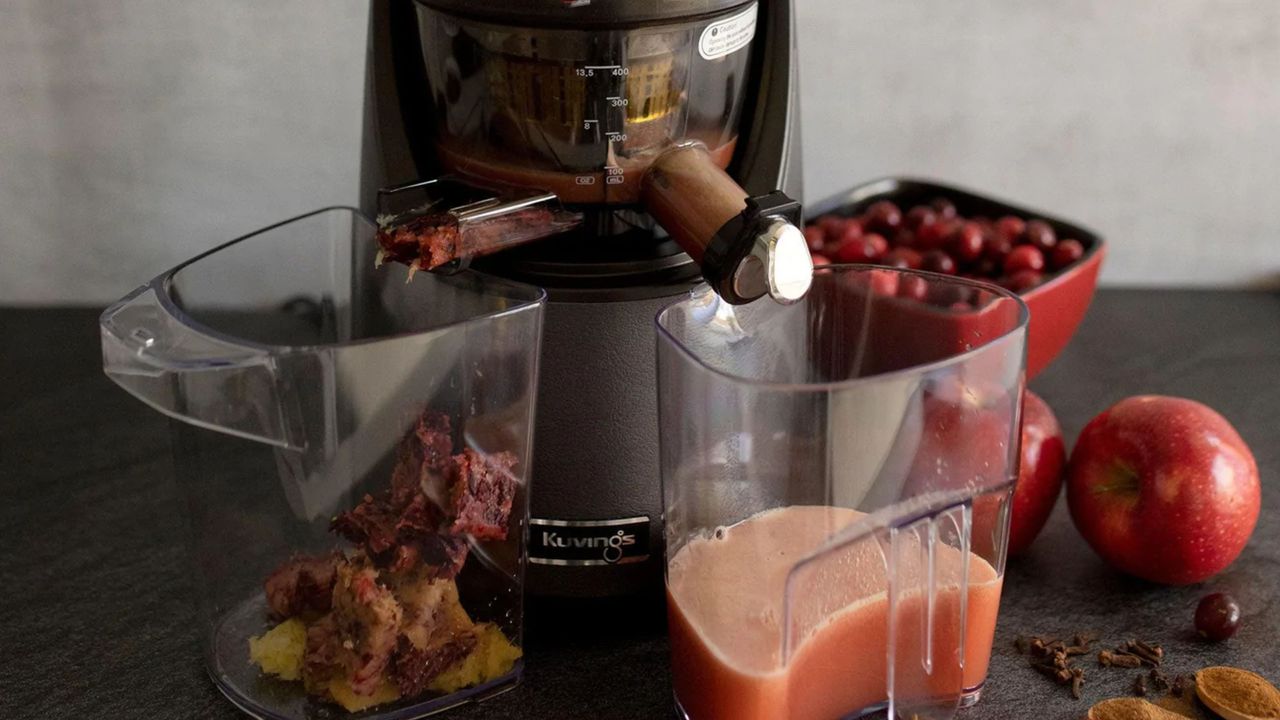
The Kuvings EVO820 is a consistently high-performer, with enough power to make smoothies, nut milk and more.
-
+
Easy to operate
-
+
Large feeding tube
-
+
Extracts lots of juice from ingredients
-
+
Makes smoothies and frozen desserts
-
+
Includes cleaning tools
-
+
10-year warranty
-
-
Many pieces to store
-
-
Must be hand-washed
-
-
Expensive
You can trust Homes & Gardens.

If you’ve ever looked into the best juicers, you’re probably familiar with Kuvings, a well-known brand that makes both masticating and centrifugal-style juicers. In its current line of juicers, the Kuvings EVO820 Whole Slow Juicer is its most expensive model, standing out thanks to its sleek design and unmatched versatility.
This masticating juicer, also known as a slow or cold press juicer, which uses a large auger to slowly chew up ingredients, comes in four attractive finishes and won’t take up too much space on your counter. Plus, in addition to slow juicing, this appliance can be used to create nut milks, smoothies, and even frozen desserts, doing the jobs of several different kitchen appliances.
We wanted to see how the EVO820 stacked up against the best cold press juicers we’ve tested, so we used it over the course of several weeks, making a variety of juices and other drinks. The appliance impressed us throughout the whole process with its consistent performance, and while it is more expensive than many other juicers, we think it’s a worthwhile splurge for anyone who regularly makes homemade juice and smoothies.
Kuvings EVO820 specs
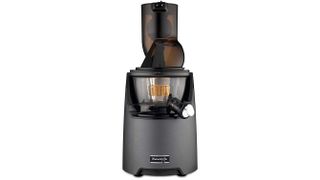
- Type: Masticating juicer
- Materials: ULTEM™, Tritan™, ABS, PC, Stainless Steel
- Dimensions: 8 x 9.5 x 19 in.
- Weight: 16 lb.
- Power: 240 watts
- RPM: 60
Unboxing
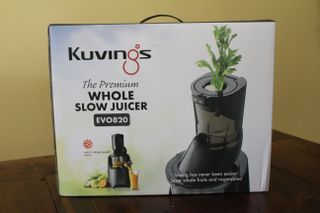
The Kuvings EVO820 Whole Slow Juicer arrived in a medium-sized box, which included the main pieces of the juicer, as well as a smaller inner box with the appliance’s accessories. I was surprised at the weight of the juicer’s base, which may be somewhat heavy for those with mobility issues.
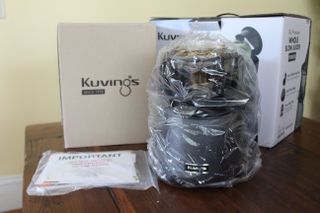
However, the real surprise came when I opened the box of accessories. This juicer comes with so many different pieces, and I was honestly shocked that they were all packed into a fairly small box. (I will say that every single piece was wrapped in plastic, which has quickly become a pet peeve of mine.)
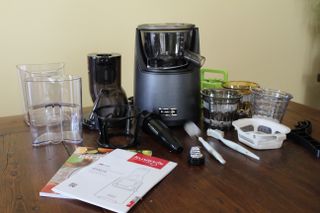
In addition to the main juicer components, the package contained a juicing strainer, smoothie strainer, blank strainer, juice cup, pulp cup, pulp strainer, cleaning tool, cleaning brush, round brush, and lid opener, not to mention the manual and a recipe book. Obviously, not all these pieces are going to fit nicely inside the juicer for storage, so my immediate thought was that it will definitely be tricky to fit nicely inside my kitchen cabinets.
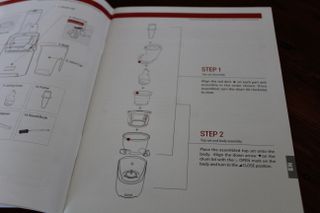
Because there were so many components, I also had to consult the manual to figure out how everything went together. Luckily, the brand makes it easy to line up the various pieces by putting red dots on each component—you simply line them up, and everything fits together nicely.
Apple, Pineapple, Grapefruit & Ginger Juice
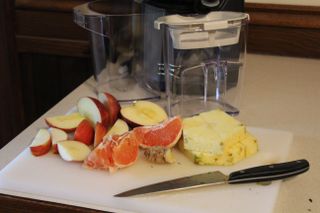
To get a feel for the performance of the Kuvings EVO820, I started by making one of my favorite juice recipes—it’s a tried-and-true combination in our household. It includes apples, pineapple, half a grapefruit, and a little bit of ginger, and it’s the perfect combination of sweet and tart.
After setting up the juicer, I turned it on and began feeding ingredients into the chute. There’s a rocker switch to turn the machine on or put it in reverse, and the appliance isn’t too loud during operation—it just sounds like a low groaning noise.
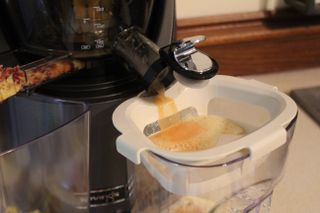
There are two ways to use its chute—when it’s locked, you can simply drop smaller ingredients like ginger into the auger, and there’s a pusher that fits through the opening in case any ingredients get stuck. Alternatively, if you unlock the chute, it becomes a “flip gate” where you place larger ingredients and it drops them in.
The auger quickly chewed up all the ingredients I put inside, and nothing got stuck in the auger or the pulp chute. The machine worked faster than other masticating juicers I’ve tested in the past, and the pulp that came out was definitely drier than that of the Breville Juice Fountain Cold Plus.
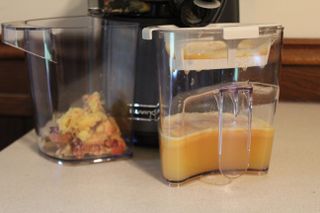
I used the pulp strainer on top of the juice collection jug to catch any pulp that made it through the filter, and it also proved to be effective at keeping foam out of the drink. However, the mesh got clogged fairly quickly, and I had to use a silicone spatula to push the pulp to the side of the filter so it would let the rest of the juice pass through. Overall, the final product was delicious and well-mixed, and I was impressed at how much juice the appliance extracted from the ingredients.
Carrot, Spinach & Apple Juice
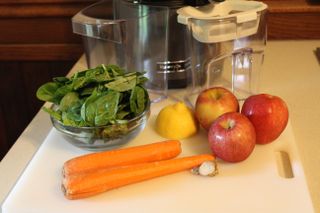
For my next test, I wanted to use some different ingredients, so I made another favorite recipe, which includes carrots, spinach, apples, and lemon. I decided to put the apples into the juicer whole to see how it would handle the larger ingredients, and I also put half a lemon in without peeling.
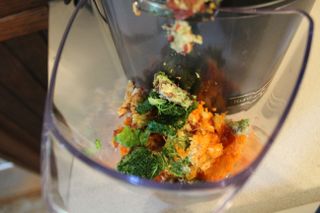
I put the carrots into the juicer first, and I was impressed at how much juice it extracted from them. The pulp came out very dry, as well. I used the flip gate to put the two apples in one at a time, and while I needed to give them a little nudge with the pusher, the auger easily chewed them up. The same held true for the lemon piece. The baby spinach proved to be a little tricky—it’s not heavy enough to put on the flip gate, but it’s hard to push down through the regular hole. A few pieces got stuck on the inside of the chute, as well, so I think next time I would put them in first so they get pushed down by other ingredients.
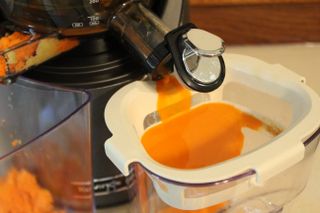
Again, the pulp strainer was quite clogged up by the time I put the last ingredients through, but I was grateful that the pulp didn’t end up in my drink. I was impressed by how easily it processed all the ingredients, including hard ones like carrots, and the resulting juice was delicious.
Almond Milk

The Kuvings EVO820 can also be used to make nut milk, so I decided to try making some homemade almond milk. I soaked 1 cup of plain almonds in water overnight, and the next day, I set up the juicer with its juicing strainer. The brand’s Almond Milk recipe calls for a 1:1 ratio of nuts to water, and I alternated pouring in several almonds then a splash of water.
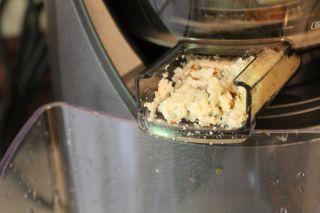
The process was straightforward, and I was actually surprised at how much almond milk it yielded—probably close to 2 cups. The crushed up almonds that came out of the pulp chute were dry and almost powdery, as the juicer managed to squeeze all the liquid out of them. However, I will say the final product was fairly gritty—the brand recommends putting the liquid through a strainer for a thinner consistency—and while it would be fine in a smoothie or other recipe, it wasn’t the best option to use in my cereal.
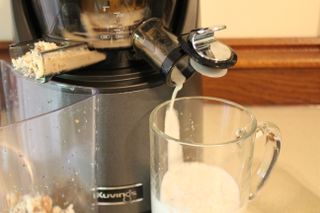
Additionally, I put the remaining milk in the fridge overnight, and by the morning, it had separated with water on top and almond grit at the bottom. Overall, I think this would only work well if you wanted to use the milk right away, and it’s honestly cheaper and easier to just buy pre-made almond milk at the store.
Blueberry avocado smoothie
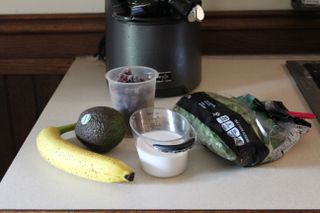
I also wanted to test the juicer’s “smoothie strainer,” which has larger mesh holes than the juicing strainer, so I decided to make the brand’s Avocado Blueberry Smoothie. When I put it in, I noticed that the smoothie strainer actually plugs up the pulp hole so nothing comes out. The directions also say to keep the pigot closed during use to ensure the ingredients get mixed together. The recipe calls for frozen blueberries, avocado, spinach, banana, and almond milk, and you’re supposed to add in the milk, then the soft ingredients, then the frozen ones.
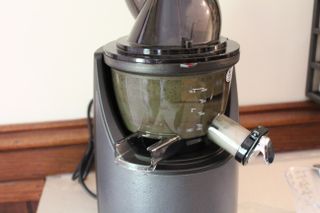
Overall, this process was very straightforward—all you really have to do is plop the ingredients in and let the juicer run for a minute or two. It had no problem crushing up the frozen blueberries, and when I finally dispensed the smoothie, it was extremely smooth and well-blended. (It tasted amazing, too!)
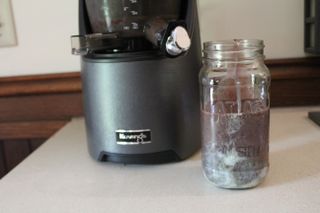
There was a little bit of almond milk in the end of the spigot that didn’t get mixed up with the rest of the ingredients, but I was able to easily stir it into the drink. I actually think the juicer did a better job than some of the best blenders at making the beverage a smooth, drinkable consistency, and I’d definitely use it for this purpose again.
Orange Creamsicle Sorbet
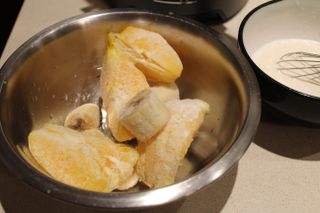
The third strainer that comes with the Kuvings EVO820 is called the “blank strainer,” and it’s used to make frozen desserts like sorbet. It’s used without the rotation wiper, and it basically just churns up frozen ingredients and pushes them out the spigot. To test this strainer, I decided to make the brand’s recipe for Orange Creamsicle Sorbet, which uses frozen oranges and bananas, evaporated milk, and vanilla yogurt.
To make this sorbet, you have to let the frozen ingredients thaw out for several minutes on the counter. I took them out and let them rest for around 15 minutes while I cleaned the kitchen. The milk and yogurt get stirred together, and from there, it’s simply a matter of adding the ingredients into the juicer, alternating between frozen fruit and the milk mixture.
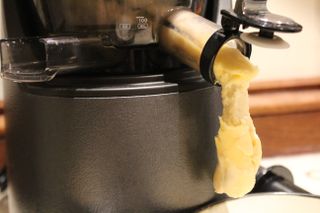
To sum it up, the recipe worked, but not well. The frozen fruit and milk mixture didn’t mix together very well, so there were frozen pieces along with liquidy bits that came out of the chute. Toward the end, a particularly large orange slice clogged up the chute, forcing me to scrape it out with a knife to keep the sorbet flowing. Once all the ingredients were processed, I had to mix the sorbet together to better incorporate the liquid into the frozen fruit, and it ended up fairly soupy. I put it in the freezer for an hour to help it firm up, but even after that, the dessert didn’t wow me. The flavor was bland, the texture was icy, and it certainly didn’t taste like a creamsicle. I much prefer homemade sorbet made in an ice cream machine, and while it’s a cool feature, I don’t think I’d use it again.
Cleaning
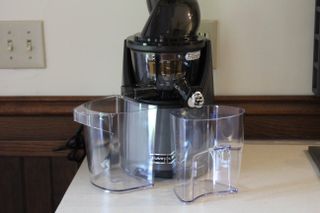
Arguably the worst thing about the Kuvings EVO820 is the cleaning process—at least in my opinion. All the pieces are supposed to be hand-washed, and because they end up covered in pulp, it’s quite a messy process. I found that it’s best to wash the juicer immediately after use before anything dries. That way, you can scrape off the biggest pieces of leftover ingredients and get most of the pulp and juice off by rinsing with hot water. If you let it sit for too long, the gunk will dry and be much, much harder to get off.
The good news, however, is that the Kuvings juicer comes with a few cleaning tools that make this process a bit easier. In particular, there’s a special tool that fits around the strainers, and it has strategically placed brushes that scrub the mesh as you twist it back and forth. There’s also a cleaning brush with a pointy end that helps to clean out the pulp chute.
Should you buy the Kuvings EVO820 Whole Slow Juicer?
The Kuvings EVO820 Whole Slow Juicer is on the more expensive end of the spectrum with an MSRP of $600. However, I think its high price is justified thanks to its quality build and versatility—many other juicers simply make juice, but this one is able to make smoothies and frozen desserts, as well. It also performs extremely well, squeezing as much juice as possible out of each ingredient, so I think it’s a worthwhile splurge for anyone who regularly makes juice.
If you’re just getting into juicing and aren’t sure how often you’ll use the appliance, you may want to start out with a more budget-friendly model, such as the NutriBullet Slow Juicer.
About this review, and the reviewer
Camryn Rabideau is a freelance writer and product reviewer who has been testing small kitchen appliances (as well as other home goods) for several years. She’s tested everything from toasters to oil infusion machines, and she recently fell in love with juicing, as it’s a great way to use up the extra produce she grows on her farm while sneaking more vitamins into her diet.
Camryn does her product testing from her small homestead in beautiful Rhode Island. When she’s not tinkering around with the latest home gadgets, she spends her time tending to her animals, working in her garden, or crafting.
Sign up to the Homes & Gardens newsletter
Design expertise in your inbox – from inspiring decorating ideas and beautiful celebrity homes to practical gardening advice and shopping round-ups.

Camryn Rabideau is a writer and product reviewer specializing in home, kitchen, and pet products. In her five years as a product tester, she's tested hundreds of items first-hand, including many, many kitchen appliances for Homes & Gardens. Camryn does her product testing from her small homestead in beautiful Rhode Island.
-
 Reese Witherspoon's patio furniture collection is inspired by Southern hospitality and charm – upgrade your summer gatherings starting at $150
Reese Witherspoon's patio furniture collection is inspired by Southern hospitality and charm – upgrade your summer gatherings starting at $150The actress's brand, Draper James partnered with POLYWOOD to create classic patio furniture that prioritizes longevity with durable, Southern-inspired pieces
By Hannah Ziegler Published
-
 Ariana Grande's kitchen lighting taps into a retro trend – goodbye, recessed lighting, statement pendants are defining 2025
Ariana Grande's kitchen lighting taps into a retro trend – goodbye, recessed lighting, statement pendants are defining 2025The mid-century modern design of the singer's kitchen incorporates natural materials and curves, and is grounded by a statement pendant light
By Sophie Edwards Published
-
 Shea McGee has transformed an empty storage closet into her new studio bathroom – and a stunning vintage wallpaper steals the show
Shea McGee has transformed an empty storage closet into her new studio bathroom – and a stunning vintage wallpaper steals the showThe sophisticated bathroom remodel feels effortlessly chic and timeless
By Eleanor Richardson Published